DEEPENING DEMOCRACY OP-ED
The contribution of the UDF and People’s Power to our understanding of freedom (Part Four)
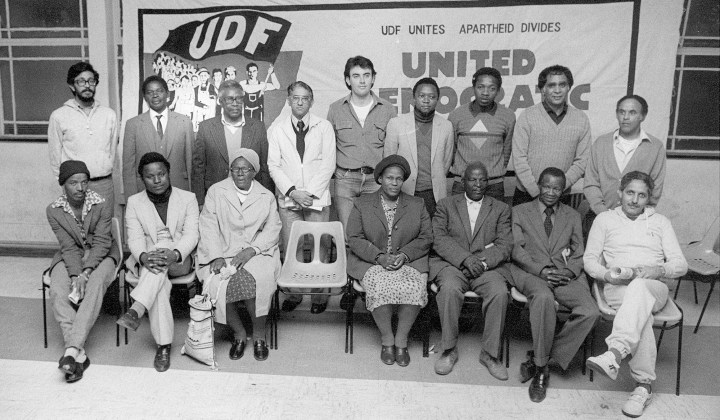
The organs of people’s power during the Struggle were not established at ANC HQ in Lusaka or UDF HQ in Johannesburg. They were initiated at the local level, whether in Uitenhage, Atteridgeville, Saulsville, Port Elizabeth, Mamelodi, Soweto, Port Alfred or Fort Beaufort.
This article is the fourth in a series. Read Part One, Part Two and Part Three.
When one considers the UDF period, we obviously want to ask ourselves, what can be taken into the present? We are living in very different times from that of the UDF 40 years ago and cannot simply transplant an organisation that was born to fight, and mobilised and organised some 600 affiliated organisations and over two million people against apartheid, into the present (a figure that does not seem to have been challenged).
The popular power period was based on a series of social relationships and organisations that no longer exist, or insofar as they exist, do so within communities that are no longer as cohesive as they paradoxically were during apartheid divide-and-rule.
One no longer has independent civics nor is the civic movement reconstructed as a national body as strong and as linked to the grassroots as in the UDF period. Nor are there youth organisations of that character and the trade union movement is in decline. There are organisations in many other sectors, like that for women that are much weaker than then.
This may not have been inevitable and did not relate purely to the extreme level of state repression. The ANC, as the dominant liberation movement did not envisage when it became the state and bearer of nationhood to coexist with popular movements independent of its sway. And in many cases, members of popular movements of the 1980s, many of whom were also ANC members, did not see their having an existence independent of the ANC — and continuing in the public political sphere.
That is why Mahmood Mamdani says that the victory of liberation movements represents the defeat of popular movements. [“State and Civil Society in Contemporary Africa: Reconceptualizing the Birth of State Nationalism and the Defeat of Popular Movements” Author(s): Africa Development, 1990, Vol. 15, No. 3/4, (1990), pp. 47-70, Michael Neocosmos describes this in the context of a periodisation of the existence of the UDF and the flourishing and decline of popular power (“From Peoples’ Politics to State Politics: Aspects of National Liberation in South Africa”, in A. O. Olukoshi, ed., The Politics of Opposition in South Africa, Uppsala: Nordic Africa Institute, 195- 241, 1998).]
The territorial space of the nation was to follow a pattern on this continent where national liberation as a popular movement was ceded to the ANC depicted as the bearer of nationhood in the process of becoming the nation and state of the future.
Although not necessarily consciously seeing the destruction of the popular in its first enunciation, this notion of a liberation movement as embodying the nation is found in slogans throughout the continent e.g. “CPP is Ghana, Ghana is CPP”, “Kanu is your mother and father” and “ANC is the nation”, referring to the Ghanaian, Kenyan and South African liberation movements respectively.
International and continental organisations reinforced this idea of the liberation movement standing in as the nation by declaring liberation movements as the sole and authentic representative of the people, in South Africa’s case referring to two liberation movements, though PAC gradually came to carry less weight and numbers.
The status of liberation movements was reinforced by the parallel and growing international law de-recognition of the apartheid regime. (Raymond Suttner, “Has South Africa been illegally excluded from the United Nations General Assembly?” (1984) Comparative and International Law Journal of Southern Africa’, 279-301).
Evaluating the conditions for success and failure of popular power
But even if there had been a desire for continuation of popular power, it is necessary to understand under what conditions this flourished and when it failed or collapsed, independent of actions by the apartheid regime. When did it succeed and when did it fail and why?
It is also necessary to consider what we can learn from attempts to set up local-level grassroots structures in the present conditions. Insofar as there may be a space — at some point — for revival of popular power, it is necessary to articulate the conditions under which popular power may arise, when it is sustainable, and when it fails.
There is no doubt that the popular power period gave people a sense and the practical lived reality of their own capacity to run their own lives, albeit on a small scale, in particular communities. This did not happen in all communities. Sometimes or often, for there is insufficient data to quantify, such successes coexisted with neighbouring communities, failing to attempt, or attempts to build popular power, collapsing for one or other reason.
Sectarianism and non-sectarianism
In the cases where there was success, this was often based on local structures like street committees, zone committees, area committees, and these were not ANC or UDF structures or intended to be that. Where they operated successfully in some communities, they did not purge non-ANC or non-UDF people. They generally worked best and the principle on which they tended to operate in the successful cases was through being non-sectarian and not demanding that members of street committees, area committees, or other organs of popular power should be members of UDF affiliates.
This is not to say that there was not a significant level of intolerance of non-“Congress” (Congress signifying allegiance to the ANC) trends among UDF/ANC supporters towards Black Consciousness Movement supporters. But that would not be manifested in communities where street communities built cohesion and amicable relations between people through engagement in community projects and dispute resolution. Such actions to secure peace could not succeed where intolerance displaced mediation and attempts to build consensus.
The ANC and the UDF, it is true, called for popular power, and in a sense oversaw the popular power period from above and at a distance. But many have recorded that popular self-empowerment took on a life of its own and many of the important gains of that period were initiated by people at the ground level, at the lowest level, deciding what was needed in their community.
That points to a very important principle in the success of popular power. It was true that the ANC and the UDF had called for the establishment of elementary organs of people’s power to fill the void left by ungovernability. Because ungovernability signified absence of governance of the ruling regime, it left a vacuum and the ANC and UDF then argued for the necessity of setting up organs of people’s power. (See Zwelakhe Sisulu, “People’s Education for People’s Power”. Issue Vol. 15 (1987), pp. 18-29).
But these organs of people’s power were not established at ANC headquarters in Lusaka or UDF headquarters in Johannesburg. They were initiated at the local level, whether it was in Uitenhage, Atteridgeville, Saulsville, Port Elizabeth, Mamelodi, Soweto, Port Alfred, Fort Beaufort and various other places.
In many of the places that I mention, at some times there were such structures and at others, they would have been crushed (or collapsed), because the UDF operated through ongoing states of emergency with a small break in between late 1985 and mid-1986. Otherwise, there was a continuous state of emergency from July 1985 until February 1990.
As indicated, the organs of people’s power were established at the local level by communities deciding what was needed where they were. Often, these townships had no recreational facilities, no places for youngsters to play safely. This was in a situation with danger and criminality, which has obviously gotten worse today.
But even then it was pretty bad, with apartheid policing focusing on the safety of whites and police stations located primarily in white areas. (Raymond Suttner, “The ‘Loading’ of Procedures in the South African Judicial Process” in J Hund (ed) Law and Justice in South Africa, Centre for Intergroup Studies, University of Cape Town, Rondebosch. (1988) Ch 8, 117-136).
Many communities took it upon themselves to establish people’s parks, where their children could play safely. They tried to organise refuse removal. The state that didn’t do it adequately before was not present anymore. Consequently, there was no authority to whom to appeal, even if unresponsive.
Titus Mafolo said of Atteridgeville/Saulsville, “People are actually coming to the political activists to try to resolve their problems and their differences. It was felt that there should be structures which will actually work with those kinds of problems and try to resolve them. And over and above, an advice office was opened by the local civic organisation, which is Asro (the Atteridgeville-Saulsville Residents Organisation), to look into the problems of the community and to try to resolve the disputes and differences which people are bringing to the activists”. (Interview Titus Mafolo, April 1986).
This type of functioning seems to have been carried out by other civic advice offices as with that under the auspices of the Soweto Civic Association. (Seen in the Complaints book of the Soweto Civic Association, in 1986).
When the community expelled the Bantu administration officials and took over the department’s building in Port Alfred, they chose to make it a creche. (Interview Gugile Nkwinti, Johannesburg, 1986). They were not simply occupying the building, as a statement of who had power in Port Alfred. They were also freeing women from some of their domestic and maternal tasks in order to enable them to play a full role as human beings and workers in South Africa.
In that same township, they recognised — and this is another principle for the success of popular power — that it was necessary to involve all members of the community in any decisions that were made, and in the process of establishing structures of people’s power in Port Alfred. They established what was called a central committee, and that central committee comprised people representing the workers, the youth, women’s section, civics, the religious sector and other sections of the community.
And at that time, it will be remembered there were very frequent consumer boycotts or stay-aways in the Eastern Cape, notably Port Elizabeth. How were these to be enforced? There were a lot of problems in the UDF because many of those drawn into its fold believed that people had to be coerced into carrying out decisions to have a consumer boycott or other action against the regime, or even to bring them under the banner of the UDF and fairly frequently there was the use of fists. (See Raymond Suttner, Popular Justice in South Africa, 1986 (unpublished).
That is an important question to which I’ll return, under the heading of pluralism. But in the case of consumer boycotts and stay-aways, how Port Alfred dealt with it — because it derived from decisions of the Central Committee, representing all sections of the community — there were very few sectors that could potentially be coerced.
It did happen that even though you had women or workers or youth represented in the Central Committee, that some people still did not want to participate. And what I was told happened is when someone went off to work, when there was a consumer boycott or stay away, you would have some children in the trees near the road, and they would say, “hey, Mama/Tata, where are you going to” or some such other form of non-physical coercion/persuasion? (Interview, Nkwinti, above). The general approach was to attempt persuasion, to try and get them to observe the boycott. However, it was recognised that it was undesirable in building people’s power — in the successful cases — to coerce people.
In many of these situations of people’s power, one of the factors that brought people into agreement on the need to set up such organs was the prevalence of crime and the need to have ways of resolving conflict. And in some communities, organs of people’s justice were established.
Many writers on the subject equate people’s justice with people’s courts. People’s justice is much wider than people’s courts. And in my view and experience — in meeting activists and interviewing some — there was not generally a need to have courts, and when there were courts, they often did not operate as well as other methods of adjudication or mediation, where there was not a need for a formal judgment and imitation of a Western court system.
In these situations, there would be an attempt to reconcile parties. Titus Mafolo of Atteridgeville did not like using the word “court” at all because of the stigma attached to institutions that operated in a manner that did not serve communities. (Interview, above).
Some have suggested that there was an influence of what happened in pre-colonial customary courts or continuing “traditional custom”. (Neocosmos at p. 204, citing Tom Lodge et al, All Here and Now: Black Politics in South Africa in the 1980s, 1991 at p. 135). I’m not sure that people intended to directly draw on traditions. However, the basis of operation was very similar to that described by Max Gluckman in his writings on customary courts in Barotseland, where he argues that the idea was not to have a formal judgment and have someone punished. The objective was to make it possible for parties to a dispute to live together as members of a community after the case was decided. (Max Gluckman The Judicial Process among the Barotse of Northern Rhodesia. 1955.).
Without wanting to romanticise African customary courts, if one looks at the Western-inspired courts, a formal judgment is made and those making the judgment have no further role in the lives of the people who are parties to the dispute.
In the customary decisions and also in popular justice, people were part of the same community. The aim was to involve everyone in decision-making, though obviously in customary processes and popular justice more influential people enjoying one or other status would carry more weight. But everyone who was part of the process had to live together afterwards. And that was one of the objectives of the process, to come to a decision that made that continued coexistence possible.
The apartheid regime saw popular justice as a particularly dangerous challenge to the apartheid state because once people appropriate one part of the state functioning like the judicial system or the prosecutorial system or the policing system, it weakens the hold of the state on power.
It had already been weakened under ungovernability, and this was a further step towards weakening apartheid, albeit moving beyond the absence of norms as tended to prevail in ungovernability, towards mutual responsibility.
Under Popular Power people saw what they were doing, as self-empowering actions aimed at building a future, not waiting for some decisive moment of so-called transfer of power or seizure of power, but to make it happen there and then. DM
This article first appeared on Creamer Media’s polity.org.za
Raymond Suttner is an Emeritus Professor at the University of South Africa and a Research Associate in the English Department at University of the Witwatersrand. He was actively involved in the UDF and in advocating People’s Power. This led to his spending much of the 1980s underground, in State of Emergency detention or under house arrest.




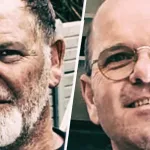


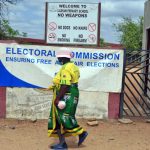
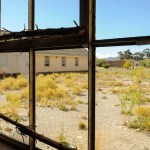
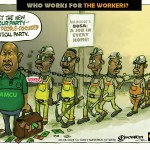
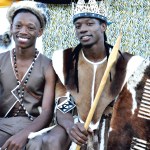







 Become an Insider
Become an Insider
Comments - Please login in order to comment.